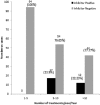Clinicopathological parameters influencing inhibitor development in patients with hemophilia A receiving on-demand therapy
- PMID: 30181842
- PMCID: PMC6116755
- DOI: 10.1177/2040620718785363
Clinicopathological parameters influencing inhibitor development in patients with hemophilia A receiving on-demand therapy
Abstract
Background: Development of inhibitors to transfused factor VIII in patients with hemophilia A continues to be a challenge for professionals involved in hemophilia care. The majority of patients in India receive 'on-demand' rather than prophylactic therapy. The present study was done to assess the prevalence of factor VIII inhibitors in patients with hemophilia A (PWHA) receiving 'on-demand' therapy in a North Indian population and to study the clinicopathological parameters influencing the development of inhibitors.
Methods: The study group comprised of 300 PWHA. Detailed clinical parameters, treatment history, bleeding profile including family history were recorded. Diagnosis of hemophilia A was confirmed by relevant coagulation tests. Inhibitors were screened using mixing based studies followed by quantification by Bethesda assay and Nijmegen modified Bethesda assay. Samples were collected from five cities in North India where a free supply of factor VIII was available and effectively used in three of these cities.
Results: In the 300 PWHA, disease phenotype was severe in 219 (73%), moderate in 62 (20.67%) and mild in 19 (6.34%), based on the factor VIII bioassay. Inhibitor prevalence was 9.6% (n = 29) and seen only in the severe phenotype. Inhibitor titers ranged from 0.8 to 108.8 BU/ml. A total of 12 PWHA had low and 17 had high titers. Correlation of various clinicopathological parameters in inhibitor-positive versus negative PWHA showed significant correlation with age at onset of disease, severity of disease, age at first exposure to treatment, annual factor intake (IU/kg/year), intense treatment episodes and bleeding manifestations like central nervous system bleed and hematuria. The total study sample had blood group B in 33.34% PWHA, followed by O (27.34%), A (24.34%) and AB (15%), however, in inhibitor-positive samples, significant inhibitor formation was associated with the ABO subtype A (19/29, 65.51%).
Conclusions: Factor VIII inhibitor prevalence in PWHA receiving 'on-demand' therapy was 9.6%. Clinicopathological correlates of inhibitor development in such PWHA have been analyzed in this novel study.
Keywords: Bethesda assay; factor VIII; hemophilia A; inhibitors; plasma derived factor VIII.
Conflict of interest statement
Conflict of interest statement: The authors declare that there is no conflict of interest.
Figures



References
-
- Soucie J, Evatt B, Jackson D. Occurrence of hemophilia in the United States. The Hemophilia Surveillance System Project Investigators. Am J Hematol 1998; 59: 288–294. - PubMed
-
- Richards M, Williams M, Chalmers E, et al. ; Paediatric Working Party of the United Kingdom Haemophilia Doctors’ Organisation. A United Kingdom Hemophilia Centre Doctors’ Organization guideline approved by the British Committee for Standards in Haematology: guideline on the use of prophylactic factor VIII concentrate in children and adults with severe hemophilia A. Br J Haematol 2010; 149: 498–507. - PubMed
-
- Di Minno M, Di Minno G, Di Capua M, et al. Cost of care of hemophilia with inhibitors. Hemophilia 2010; 16: e190–e201. - PubMed
-
- Astermark J, Santagostino E, Keith Hoots W. Clinical issues in inhibitors. Haemophilia 2010; 16(Suppl. 5): 54–60. - PubMed
-
- Schwaab R, Brackmann HH, Meyer C, et al. Hemophilia A: mutation type determines risk of inhibitor formation. Thromb Haemost 1995; 74: 1402–1406. - PubMed
LinkOut - more resources
Full Text Sources
Other Literature Sources

